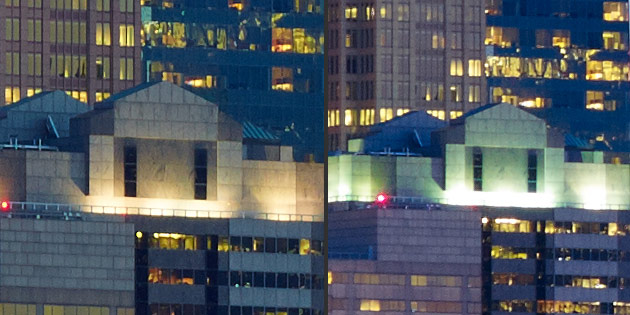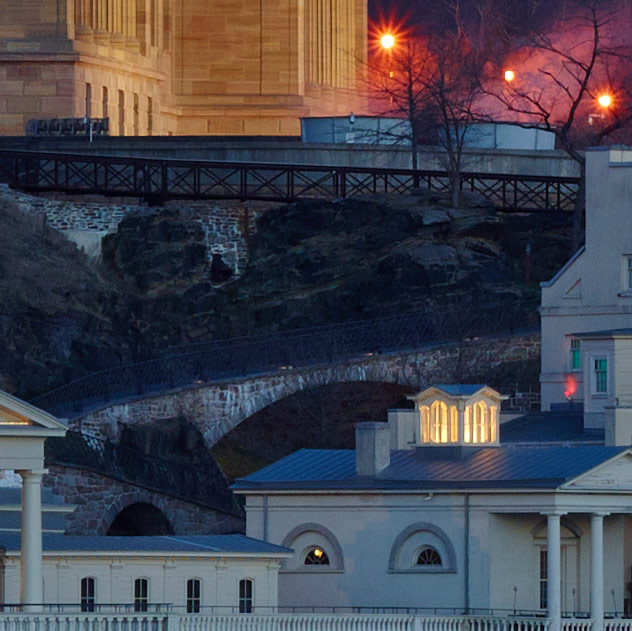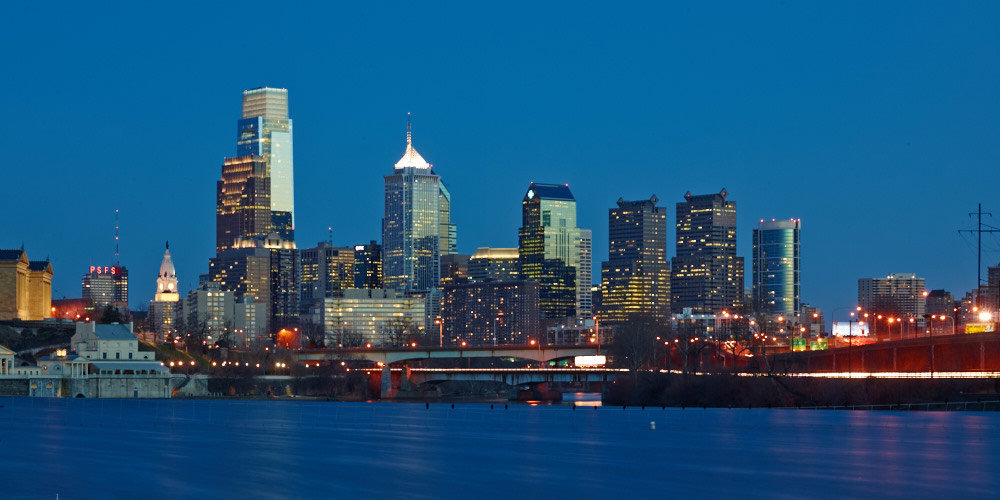Gear Testing, Phase One
Phase One IQ260 vs P45+ Long Exposures
IQ260 with Schneider 120mm lens on tech camera. 30″ @ ISO50. Shot by Jeff Totaro & Lance Schad
A Meeting of the Kings
The Phase One P45+ was the King of Long Exposure from it’s birth until the introduction of the IQ260. With production units of the IQ260, Heir to the Long Exposure Throne starting to ship we thought we’d share some differences we’ve noticed between the long exposure prowess of the P45+ and IQ260 regarding color, dynamic range, and shadow tonality.
Color and Dynamic Range

100% crops from IQ260 (left) and P45+ (right).
It’s widely known that Dalsa sensors (like that of the IQ260) and Kodak sensors (like that of the P45+) produce colors that range from subtly different to radically different. But even knowing that difference intimately we’ve been caught off guard at how strongly this difference manifests itself in artificial lighting during night-time long exposures. Specifically the IQ260 has shown significantly improved differentiation and subtly in reds, yellows, and oranges in the myriad lighting common in night scenes.
Take for example the image above: it might seem at first glance that the white balance of the images has not been matched, but look closer: the P45+ image is too green on the center triangular structure and too magenta in the frame-lower-left facade. Feel free to play with the white balance on both raws (info on downloading raws at bottom of article). The difference in color here is not white balance, it is a consequence of the improved IQ260 sensor color response, improved IR filter, and improved color profile.
In this image there are many examples of subject matter which, in the P45+ capture, are shown as the same color, but which the IQ260 (accurately) shows as subtly different colors. For instance the row of windows in the top right which are shown as red-then-orange-then-greenish in the IQ260 but are all the same yellow-ish hue in the P45+ capture.
“Color is subjective” is a truism that is thrown around a lot without deeper consideration. White it is absolutely true that final color rendition is completely subjective*, it is almost always desirable to have better and more accurate color differentiation. It’s much easier to enhance or reduce the difference between two colors than to create a difference where none was recorded.
In addition to color, this comparison shows the difference in dynamic range of these two digital backs. Look in areas like the magenta aircraft-warning lights, the up-lighting at the bottom of the triangular structure and the overhead lights inside the offices. There is a dramatic difference in these areas in the absolute amount of detail, the color accuracy, and the smoothness of the tonal roll-off. This is representative of the increased dynamic range we’ve seen in all types of shooting with the IQ260 vs the P45+. Since the 2007 release of the P45+ improvements have been made in sensor design, electronics, and signal processing. This is especially noticeable in night scenes where the difference between highlights and shadows can easily exceed a dozen stops.
Shadow Tonality

A 100% crop from the first image in this post. IQ260, 30″ @ ISO50, with 20 points of shadow recovery.
We expected the IQ260 to do quite well regarding detail retention in deep shadows, but it was only once we started doing real-world shooting (not just studio tests) that a difference in tonality really came forward. Take for example the 100% crop shown above. This should be a nightmare for a digital camera: finely detailed dark blue subject matter**, deep in the shadows of a long exposure, with the shadow recovery pulling up the tones in the darkest areas. We’re impressed with both the absolute amount of detail shown, and the smoothness with which the subject matter ramps out of the deep shadows into the quarter tones.
Request Raws from the Philly Skyline and More
We have 18 raw files from the Philadelphia Skyline shoot ready to share. They range from 3 seconds to 8 minutes, and include frames at both ISO50 (normal mode) and ISO140 (long exposure mode) on the IQ260 and ISO50 on the P45+. We also have wedding, portrait, still life, landscape, and art reproduction raws from the IQ260 (and nearly all other Phase One and Mamiya Leaf digital backs).
To arrange to receive any of these raw files or to arrange your own hands-on testing contact us today.
Notes
*with obvious exceptions for areas like art reproduction and product photography where accurate color trumps pleasing color and there are specific criteria like FADGI to measure color performance against.
**Because nearly all digital cameras use Bayer patterns only one out of four pixels “sees” strongly-blue subject matter. This leads to increased noise in dark blue subject matter recovered from shadows, especially when compared to dark green subject matter.
***In this particular frame the P45+ is a bit softer than expected, likely due to environmental vibration (heavy tripod, mirror-up and self timer was used, but wind or vibration from passing traffic is still possible). Other images in the sets of raws would be better for comparison of detail and sharpness; this image is being discussed for it’s color, dynamic range, and tonality which are not effected by slight loss of sharpness

